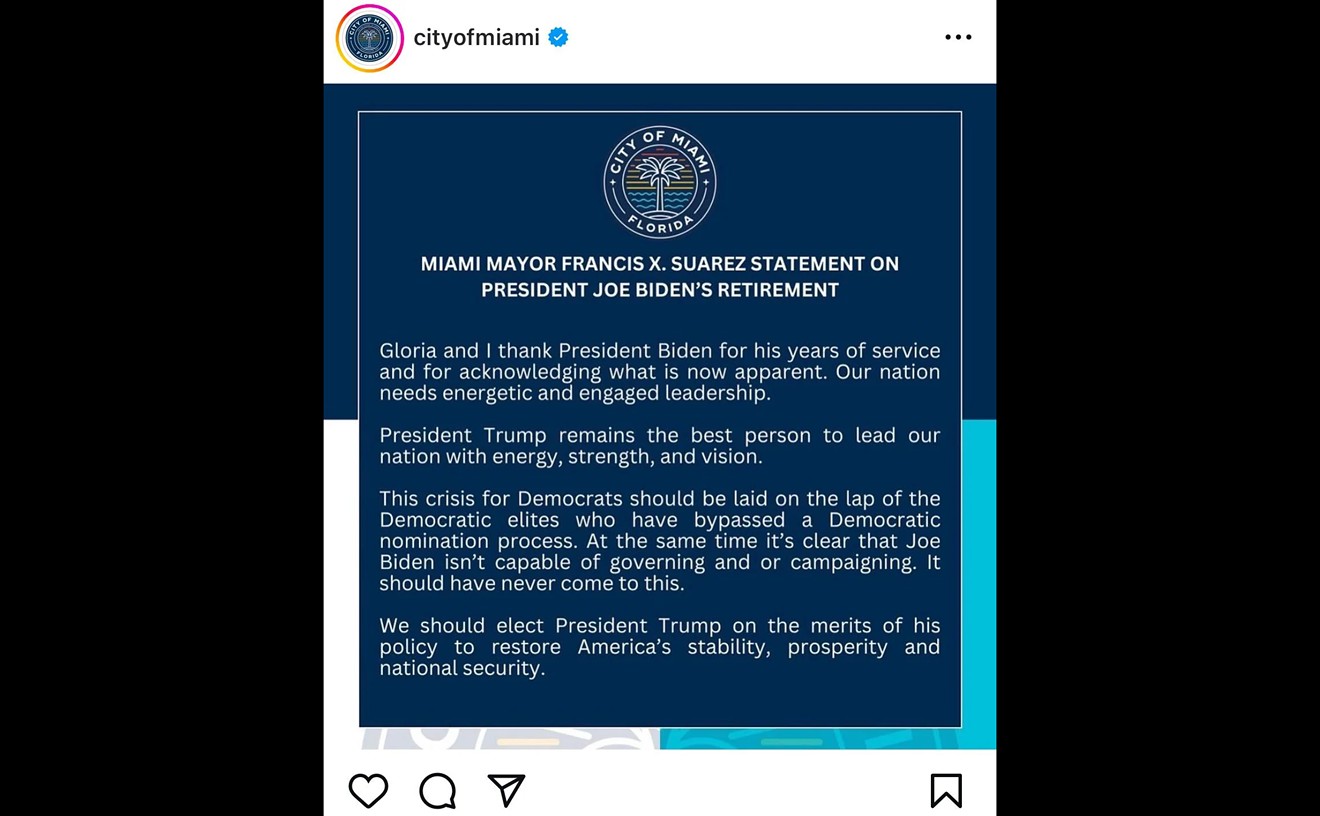And by the way, I'd be happy to draft a new campaign-finance law: A few comments about Brett Sokol's "Kulchur" column on the never-ending subject of Don Peebles et al. ("Black and White and Dread All Over," June 26). First of all, Florida desperately needs a campaign-finance law with teeth in it. Having worked as a researcher on countless political campaigns, I am very familiar with the way corporations, clients, employees, and family members are used to circumvent the $500 contribution limit, often resulting in tens of thousands of dollars being poured into a single campaign by one individual. If our legislators can't figure out how to design such a law, let them call me -- I'm in the phone book. I could create a perfectly effective and fair law in about an hour.
Second, I would like to urge Brett Sokol to come out of the pro-development closet and finally admit his antipathy toward our reform-minded mayor, David Dermer. If he's not attacking Dermer directly, he's attacking him by association or by implication.
Third, Sokol is constantly invoking Armando Gutierrez as the Great Satan of Miami-Dade politics. I've been working with Armando for two decades and he has been fair with me and his clients -- and their adversaries. The only time he ever publicized an inaccuracy -- unknowingly -- was in 1984, and that was the result of a misprint in the Florida Senate Journal. He's good at what he does, and a lot of people don't like that. As far as his being "PR spinmeister" for Elian Gonzalez's Miami relatives, whatever Sokol's view may be in that case, I can personally vouch for the fact that Armando's commitment to the family was personal, emotional, deeply sincere, and that he ended up losing considerable income because of it.
As for the allegedly unpalatable Barreiro brothers, Gus has been one of the most effective state representatives, progressively inclined and respected on both sides of the aisle. He replaced his brother Bruno, who has since become an effective representative for South Beach on the Miami-Dade County Commission. And among the "politically reactionary" Diaz de la Portilla brothers is Miguel, who as a county commissioner was that body's number-one promoter of ethics laws for local government. I guess Sokol is pleased that Alex Penelas beat him three years ago in the race for county mayor.
Richard Rosichan
Miami Beach
If you believe the Freedom Tower is worth that much, I have some swampland you'll just love: Congratulations to New Times for publishing Kirk Nielsen's well-written and well-researched article about MDCC president Eduardo Padrón and his effort to buy the Freedom Tower ("Bad Man on Campus," June 19).
I am a commercial real-estate broker. Presently I am representing an investor interested in purchasing the Freedom Tower. I went to the Miami Herald and the Daily Business Review with questions about this subject, but neither paper took my concerns under consideration. My main question was this: Where did the Herald get the numbers it published in an April 12 article about MDCC possibly buying the Freedom Tower? The article stated, "The building ... is valued at about $25 million to $27 million." Who did the Freedom Tower appraisal?
Marta Sala
Coral Gables
Poor things, they'll be so lonely without their friends at county hall: Regarding "Shiver: Winners and Losers" (June 19): I live in the Redland and have watched over the past two years as developers have paved over crops. It's refreshing to know I wasn't crazy when I questioned why the county's Department of Environmental Resources Management kept approving so many developers' applications to change agricultural land to tiny single-family-home lots in the middle of avocado groves. Now, with Steve Shiver gone, those developers won't be able to build condos in the Everglades. What are they going to do?
Thanks to New Times for such an honest look at a county gone mad (and hopefully now returning to sanity). I salute Shiver "winners" Katy Sorenson, Angela Gittens, Chuck Lanza, Constance Kaplan, and South Florida's fragile ecosystems. And I hope voters remember who ran the county into its deep debt and destroyed its agricultural land.
Pamela Gray
Redland
Shiver: Give the Kid
a Break
He's honest, he has integrity, and he's a high-tech wizard: I am writing to offer what appears to be a dissenting opinion to all those, including New Times, who have written negative epitaphs of Steve Shiver's service as county manager ("Shiver: Winners and Losers," June 19). I write as a personal friend of Shiver and as a lobbyist who has never made a penny from Miami-Dade County and makes what I consider to be an honest living in Tallahassee -- not in South Florida.
First New Times's characterization of Homestead as a "hapless" community: If Miami-Dade had the spirit, sense of community, and promise that Homestead has, we wouldn't be considered the banana republic that we are outside our community. Homestead is the last great frontier and a wonderful place to raise a family and prosper and grow in business. I know. I've represented the city in Tallahassee since before Hurricane Andrew, through Andrew, and post-Andrew.
On to Shiver: What a thankless job. If you do anything right, you have thirteen commissioners and a mayor taking credit for it. If some initiative fails, they all run for cover and point a finger at you. I join Mayor Penelas in calling for the elimination of the position. No one can successfully operate in that climate.
Shiver brought the county government into this century; he is a technological wizard and carried that wisdom and vision to the county. He had by far the best relationship with county employees of any of his predecessors, fostered by being a man of the people and spending time with the many county employees, listening to their concerns and problems, and trying to deal with them. He comes from a family of public service: His father, R.S. Shiver, is the longest-sitting public official in South Florida as a Florida City councilman. Steve Shiver has continued that tradition and done so with honesty and integrity.
It's easy when he's gone for Katy Sorenson and Jimmy Morales and others to throw dirt on the grave. At least Katy acknowledges her long-standing dislike of Shiver. If he made any mistake it was naively believing he could effect change for the good and take credit for it.
He has served this community with integrity and leadership for almost half his life, and he's only 37 years old. Give the guy a break. Give our community a break. We need to stop this spiral of self-defeat and negativity. It's time to move on, time to circle the wagons around George Burgess and deal with the serious problems facing our community.
Bob Levy
Miami
Reporting Lapse on Laps
Let's put the brakes on those inflated go-cart figures: I started to read Eric Barton's article "0 to 60 in 3 Seconds" (June 12) with great enthusiasm, but was later disappointed and concerned. First let me point out that I have been involved with the sport of go-cart racing for at least 26 years and my son is a third-generation racer in the Cadet class noted in the article. He was also the Cadet-class winner of last year's event in Jacksonville.
One problem was parents shelling out "as much as $10,000 to outfit the go-carts." No way. A complete Cadet go-cart will cost from $2400 to about $3600, depending from whom you buy. Carting is one of the cheapest motor sports available.
Another problem: $50,000 per year in expenses? Maybe if we all flew first class and always stayed in five-star hotels. As for the mechanic's costs, I do all the work on my son's go-cart, as do many other parents. It's not big science. This helps my son and I get close to each other. The best thing for me is that at the end of the day he always says, "Thanks, Dad." That is worth a million.
As for bumping other go-carts during a race, that really hit home. My son is one of the many conscientious racers who would never consider hurting anyone on the track. I would hate to see a driver get hurt because someone thought that bumping is the right thing to do. It is unacceptable to hear that other drivers may believe this is even an option. This is go-carting, not NASCAR. For the article to suggest that bumping is a common practice among go-cart racers is misleading and false.
As for the number of deaths and injuries, I have never seen the figures used in the article, which was a black eye for go-carting families throughout the U.S. Go-carting is an excellent family sport that promotes values and sportsmanship.
Steven Quinones
Pembroke Pines
How Do You Measure Success?
For starters, it has nothing to do with the color of your skin: I was completely offended by the cover headline of New Times's June 5 issue: "Bitch-Slapping Whitey." The February 6 cover story you published about me and my projects, using the headline "Beating Whitey," was offensive enough, but this most recent cover was excessively insulting and extremely racist.
Even worse was the cover photograph that accompanied "Bitch-Slapping Whitey." The photo featured a clean-cut white, corporate-looking man being slapped in the face (glasses askew) by a black hand wearing a gold-and-diamond pinky ring and a gold wrist chain. The black hand as well as the headline clearly represented a negative depiction of an African American. I cannot believe in this day and age a cover like that would be produced, and in all good conscience I could not let it slide without comment.
Both covers imply that I am successful because I am an African American who "plays the race card." This could not be further from the truth. Just to be clear, the Royal Palm hotel project in Miami Beach was the first "African-American designated" project in which my company has participated. Prior to that project my company owned or developed more than one million square feet of commercial real estate in Washington, D.C.
The article correctly pointed out that my company and I are trying to resolve a financial matter with the City of Miami Beach regarding environmental and structural issues encountered during the construction of the Royal Palm. The fact is we incurred $19 million in costs and a two-year project delay because of these issues, which had nothing to do with race but rather with business.
Our project opportunity was created in 1993 at the same time the Loews hotel project was created. The City of Miami Beach decided to invest money for the construction of two headquarter hotels to support the recently expanded Miami Beach Convention Center. A request for proposals was issued for the construction of an 800-room hotel and an African-American-owned hotel (as part of the settlement agreement reached to end the African-American tourism boycott of Miami following the disrespectful snub of South African leader Nelson Mandela).
The Loews won the 800-room hotel project in 1994. Although the African-American-owned hotel project was awarded at the same time, it was rebid in early 1996 after the city terminated negotiations with the winning African-American team. We won the project in June 1996.
Although the projects are located next to each other and were built for the same purpose, they have never been treated equally. The Loews project received $56 million from the city -- $32 million as a grant and $26 million to be paid back over a 99-year ground lease at a base rent of $500,000. The Royal Palm project received $10 million from the city to be paid over a 25-year period at a base ground rent of $490,000.
It's important to note that the Loews has 800 rooms and the Royal Palm has 417, yet on a per-room basis the Loews received three times the public investment as the Royal Palm. Obviously the Royal Palm has been put at a competitive disadvantage, even more so when the cost overruns are factored in. This is not a level economic playing field, regardless of race.
It is discouraging that every time I try to point out these disparities or ask the city to recognize its responsibilities for the cost overruns, I'm accused of playing the race card. I have approached these issues as a businessperson, not as a person of color. The truth is the hotel came into being to resolve social injustices. I am proud that I and my company had an opportunity to break a barrier, as the Royal Palm is the nation's first convention hotel developed and owned by an African American. The irony is the city asks me to accept unfair treatment because I am African American.
Your covers have done a great disservice not just to me but every successful person of color. The implication is that to gain opportunity and success, people of color must use their race. To the contrary, like many people of color, I am a successful businessperson who would be successful no matter what color I happened to be.
R. Donahue Peebles
Coral Gables
Way, way, way off: I would like to compliment Chuck Strouse on his article concerning the incompetent and unprofessional manner in which the Miami Herald brought to public attention the story of jockey José Santos ("Horsing Around with Journalism," May 29). The fact that he worked with some of these people for six and a half years and still had the integrity to write this story is a tribute to his character.
Why, after all the facts were gathered and the picture sent to the stewards, did no one have the common sense or decency to speak to Santos to confirm what he actually said -- since the reporter knew he couldn't really understand Mr. Santos?
I am of the opinion that the stewards were almost as much to blame for this incident as the Miami Herald, since the stewards are responsible for the integrity of the sport. They should have immediately looked at films of the race. They would have realized this was just a misleading photo, not a "suspicious" photo, thus putting an end to the story. I also blame the Racing Forum for publishing the picture on the front page. They could have immediately rebutted the Herald's story by simply looking at photographs of the stretch run. They would have been heroes instead of accomplices.
The true story didn't matter to the Herald or any other paper that publicized it without first scrutinizing the photo, verifying the facts, and calling José Santos for his side of the story. Bottom line: Sensationalism sells papers at the expense of innocent victims.
Tom Labriola
Delray Beach











